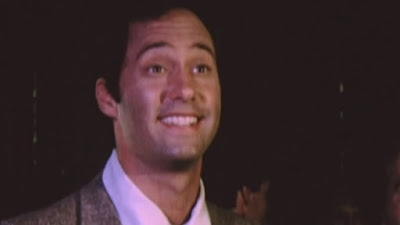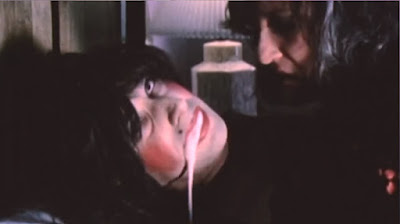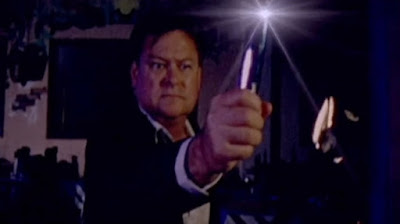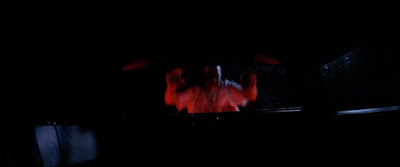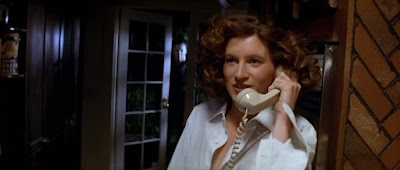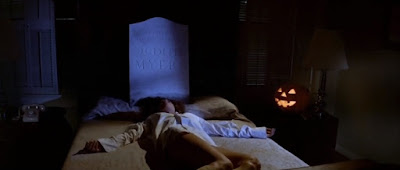Mark Pirro
In the director's previous genre spoof A POLISH VAMPIRE IN BURBANK (1983), the titular bloodsucker had several awkward, uncomfortable and not horribly funny encounters with a strange-haired weirdo who referred to himself as a “Queerwolf.” That character was basically used for a couple of gay panic throwaway jokes and not really further elaborated upon. For some reason, Pirro decided to give this horny and mysterious “creature” its own movie. Well, scratch that. I guess I kind of do see why. A title like this probably would have leapt right off the video store shelves back in the day, granted the rental outlet would even carry such a title. I never once saw this at any video store I ever visited in my youth. Then again, I grew up mostly in conservative, uber-Christian areas of the U.S., so that's not too surprising. For the record, Pirro stated he made this movie due to the “Queerwolf” being one of the most popular characters from Polish Vampire... which I find hard to imagine!
The pre-credit opening sequence throws us right into the action as a priest (producer Sergio Bandera) and three other torch-carrying men (including the director) hunt down a woman dressed in lingerie. Once they corner her, they drive a "stake" into her and are then on their merry way. We then jump to "one day earlier" and head to the Hollywood A Go Go strip club where womanizing scumbag Larry Smalbut (Michael Palazzolo) and his equally scuzzy, sex-and-skin-mag obsessed bud Richard "Dick" Cheese (Kent Butler) are watching the show. Despite living with his oblivious long-time girlfriend Lois (Taylor Whitney), Larry's been going out every night, getting drunk, hitting up strip clubs and having sex with "sleazy women" behind her back. He's been using the ole "had to work late" excuse the entire time but she needn't worry as any time he "screws another chick" he has the "common decency" not to do it in their home. Well, that's reassuring.
Larry and Dick are both doctors (!) who work at a very questionable psychiatric clinic. One of Dick's patients is an obese woman he administers electric shock to whenever she tries to cram Twinkies and donuts into her mouth. After he gets distracted on the phone, he forgets to take his finger off the shocker button, fries the woman's face off and then casually slips out of the room (!?) The accidental killing of patients becomes one of many running gags in the film. The next patient (played by Conrad Brooks) shows up trying to quit smoking and dies because he's left in a room breathing in carbon monoxide fumes from a plastic tube. And then we get a cameo from Forry Ackerman, who shows up trying to quit drinking and ends up exploding when he's pumped full of liquor. Another recurring gag is that our "hero" keeps accidentally killing his dogs. Dog #1 is told to sit and stay in the driveway and then he accidentally backs over it with his car. The replacement dog gets stabbed and then a doggie #3 (a puppy) explodes after being microwaved. Funny? Well, uh, let's see... Where were we again? Oh yes, queerwolves...
So the pals head out to a bar to watch a "skimpy bikini contest" (which we never see), pick up two ladies; Holly (Darwyn Carson) and Paula (Cynthia Brownell), and take them back to Dick's place. There, we're treated to a couple of funny bits, including Dick fixing the girls a fishbowl-sized glass of wine to loosen them up and Larry and Paula left alone on the couch trying to mess around while a radio broadcast warns of a new venereal disease that's struck the area. After Paula bites Larry on the ass, he flips her over, notices she has her bra stuffed and finds out something else unexpected about her: "Holy Jesus Christ! It's a fuckin' dude!"
Before he can do much about the "God damn fag," there's a knock on the door and the quartet of "dickanthrope" hunters are there to kill Paula / Paul. The torch-carrying mob is led by Mr. McFarland (Jim Bruce), Paul(a)'s father, who wants to exterminate his own offspring because, uh, well, basically because he's been turned gay and now can infect other heterosexual men and also turn them gay. Who wrote this thing; Pat Robertson? Before McFarland heads out to kill his son, he warns "Even a wrist that is strong and firm and holds up straight by day may become limp when the moon is full and the Queerwolf comes your way."
Ignoring the bite on his ass and having learned his lesson about the dangers of casual sex, Larry returns home to Lois and promises never to stay out late again. That night he has a nightmare about a pair of toothless "queerbillies" coming at him hoping to make him squeal like a pig as a banjo player sings a truly terrible takeoff of The Beverly Hillbillies theme song that ends with lyrics like "Pig squeal that is. Pumpin' butt. Packin' fudge." The next day a news broadcast covering Paul(a)'s murder comes on and the anchor claims no coroner in the county will do an autopsy on the body because he was wearing women's clothing at the time of his death. Eh. Let's hope that's some kind of botched attempt at social commentary and not an attempt at humor there...
Larry starts immediately showing signs of infection. He goes through a full moon transformation that involves his wrists going limp, make-up appearing on his face, long polished nails breaking through his fingertips and a red hanky appearing in his back pocket. He passes on Cheri magazine for a copy of Studflix. After one of his blackouts, Larry wakes up naked in a bathhouse with lots of satisfied male admirers sitting by. At a restaurant, he bites a bunch of guys, resulting in a queerwolf infestation. A gypsy (Sharon Alsina) he accidentally runs over sees a "pansyogram," five-sided pansy and the sign of the queerwolf, on his palm. She later gives him a John Wayne medallion to keep the curse at bay and clues him in on the only way to destroy the queerwolf: Drive a silver dildo up its ass. While all that's going on, the wolf hunters are after him and a "homo-cide" detective, who specializes in "the murders of homos," shows up.
Lacking almost all of the charm of Polish Vampire, this shot on Super 8 effort not only looks far worse (at least the copy I viewed did) but is filled with unappealing characters and throwaway side gags used to pad out the time because the director came armed with a gimmick but short on ways to elaborate upon it in an interesting, thought provoking or (usually) funny manner. Though there are a few clever / amusing moments, most of the attempts at humor fall flat in their mean-spiritedness and the film deteriorates into a really bad Exorcist parody by the end, complete with a "Fagxorcist" (Hugh O. Fields) who uses beer as holy water and flings photos of Bogie, Mr. T and Burt Reynolds at the afflicted. Of course, The Wolf Man is referenced throughout, but there are also jokes influenced by Deliverance, Poltergeist, The Wizard of Oz and other films.
While this has been accused of being homophobic by certain viewers, I don't think it's quite so cut and dry in this particular instance. Still, I'll look at both sides of the issue. In the 80s, LGBT folks were still struggling for equal rights, trying to navigate their way through the terrible AIDS crisis and getting spit on, belittled and scapegoated every which way by moralists, so for a hetero director to then come along and ridicule them further could, I suppose, be viewed as tasteless, insensitive, what have you. Then there's the premise itself, which rests on the idea that homosexuality is a malady that must be overcome / snuffed out, minus anything to counterbalance that. However, it also should be noted that none of the characters in this really come out the other end looking so good. The male leads are disgusting slobs, the priest is a voyeur / pervert, the rednecks are drooling idiots and most of the females are apparently brain damaged as no sane woman would be interested in having sex with (let alone dating) either Larry or Dick, yet here they are. So, for what it's worth (very little it turns out), this is pretty equal opportunity in showing everyone in a terrible light. If you're looking for a more positive (and funnier) gay-themed low-budget genre film from this same time, check out LOVE BITES instead.
Filmed in 1986 on a 10,000 budget, this had a post production delay (it was shot without sound so all the dialogue needed to be looped in) while the director went on to make Deathrow Gameshow (1987) for Crown International. The initial home video release came from (gulp!) Raedon, who apparently were going through bankruptcy when they acquired this so they weren't able to distribute many copies. The 2002 MTI DVD release comes with a 30-minute mini- documentary, Curse of the Queerwolf: Completely from Behind. It's narrated by Pirro film regular John McCafferty, who plays one of the rednecks here, and features interviews with the director, Butler, Whitney, Ackerman and others. No one has anything nice to say about male lead Palazzolo, who apparently caused many production headaches and other issues during filming.
★1/2



























